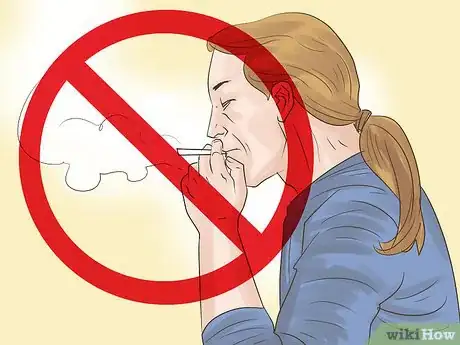This article was co-authored by Tanisha Hall and by wikiHow staff writer, Kyle Hall. Tanisha Hall is a Vocal Coach and the Founder and Executive Director of White Hall Arts Academy, Inc. an organization based in Los Angeles, California that offers a multi-level curriculum focused on fundamental skills, technique, composition, theory, artistry, and performance at a conservatory level. Ms. Hall's current and previous students include Galimatias, Sanai Victoria, Ant Clemons, and Paloma Ford. She earned a BA in Music from the Berklee College of Music in 1998 and was a recipient of the Music Business Management Achievement Award.
There are 9 references cited in this article, which can be found at the bottom of the page.
This article has been viewed 693,556 times.
If you’re trying to learn how to scream sing, you may have experienced a hoarse voice or aching vocal cords. When not done properly, scream singing can cause serious damage to your voice. To scream sing the right way, you should start with vocal warm-ups and conserve your voice with a microphone and vocal fry. By using these techniques and taking care of your voice when you’re not singing, you can start scream singing like a pro without wrecking your voice.
Steps
Getting Down the Basics
-
1Breathe from your diaphragm, not your chest.[1] Your diaphragm is the muscle located below your lungs. When you take in a deep breath to scream sing, you should feel the breath fill up your diaphragm around your stomach area. If you feel your chest lift up a lot when you take in a breath, you’re breathing from your chest and not your diaphragm.[2]
- Breathing properly while you sing will prevent unnecessary wear on your vocal cords.
-
2Layer your screams over the notes you sing. Remember that you still want to be singing in tune when you're scream singing. You're not just screaming the words of a song; you're singing the words and adding screams to your singing. Think of it as two layers: the first layer is your regular singing voice, and the second layer is your screaming voice. Combine the two layers to create the scream-singing sound.[3]
- Practice layering your screams over your singing voice by singing normally and gradually transitioning into scream singing. Choose a note and sing it in your regular voice. After holding the note for a few seconds, start to layer a scream over the note until you're scream singing the note.
Advertisement -
3Identify the vocal placement for high and low screams. These different types of screams come from various places in the body. Similar to regular singing, high note screams come from the nasal cavity, and low note screams come from the chest.[4]
- Listen to a song that has scream singing in it and try to copy the placement of each scream. Don't actually make the full screaming noise. Just do a soft whisper scream so you can feel where each type of scream should be coming from in the body.
- The song "Painkiller" by Death features scream singing in the high vocal range. Listen to "Feed the Machine" by Red to hear low note screams coming from the chest region.
-
4Scream sing using vocal fry. Vocal fry is the creaky, low-pitched way that some people speak. Open your mouth and slowly let out a low "ah." Don't project your voice or breathe out as you're doing it. The cracking effect you hear in your voice is vocal fry. Singing using vocal fry can create a distorted, screaming-like effect that won’t hurt your voice.[5]
- Practice singing vocal fry by choosing a song you like and singing the words with vocal fry. Notice how the words sound raspier. As you practice, try going louder with your vocal fry so it sounds like a scream.
- Matt Shadows of the band Avenged Sevenfold uses vocal fry to scream sing. Listen to the song "Critical Acclaim" to hear him using vocal fry.[6]
- Vocal fry is generated from the ventricular folds, which are not the same as the vocal folds.[7]
Singing Properly
-
1Warm up your voice before you scream sing.[8] Warm-ups will better prepare your voice for scream singing so it’s not as vulnerable to damage. Try to do a few different singing warm-ups before every practice session or performance.
- Start your warm up with a simple lip buzz. Close your lips and then vibrate them so they’re rapidly hitting against each other. Hold your pitch for a few seconds and then go up or down a pitch. Keep vibrating your lips and trying different pitches.[9]
- You can also warm up by singing “mah-may-me-mo-moo.” Using one note, sing “mah-may-me-mo-moo” slowly but all in one breath. Once you finish, sing it again, this time going one note higher. Continue until you’ve gone all the way up the scale.[10]
- Sometimes, your voice might seem like it's not warmed up, but you're actually struggling because of something unrelated to your voice (like being nervous about singing in front of a teacher that makes you feel insecure.) In that case, you should focus more on resolving the emotions that are interfering with your voice rather than just trying to focus on technique.[11]
-
2Scream sing into a microphone to conserve your voice. Scream singing can place a lot of strain on your vocal cords, especially if you’re trying to project your voice. Use a microphone whenever you’re performing (or practicing if you want to sing loudly) so you don’t need to project your voice as far.[12]
- Be careful not to scream sing too loudly into a microphone. You don't want to damage listeners' ears.
-
3Drink water during breaks from singing. Whether you’re practicing or performing, it’s important that you keep your vocal cords hydrated when you’re scream singing. If you’re performing, bring a bottle of water on stage with you and take a few sips after each song.
-
4
Taking Care of Your Voice
-
1Drink lots of water every day to keep your vocal cords hydrated. Try to drink 6-8 glasses of water a day. You can also drink warm tea with honey to help soothe your vocal cords if they feel irritated.[15]
-
2Cut back on alcohol and caffeine. Alcohol and caffeine dry out your larynx and vocal folds, making your voice more susceptible to damage when you sing. If you know you have a performance coming up (or you’re going to be practicing a lot) try to limit your alcohol and caffeine intake during the days leading up to it.[16]
-
3Don’t smoke. Smoking and inhaling second-hand smoke can damage your vocal folds by causing irritation. Combining smoking with scream singing will make your voice more susceptible to damage.[17]
-
4Try to exercise frequently. While it may not seem like exercising would have anything to do with your voice, regular exercise can improve your stamina and breathing capacity, which will help you speak and sing better. Try to fit some cardio into your routine a few days out of the week.[18]
-
5Use a humidifier if you live in a cold or dry climate. A humidifier will work to keep your throat hydrated so your vocal cords don’t get too dry. Turn your humidifier on before you go to sleep every night. Try to keep your living space at around 30 percent humidity.[19]
Community Q&A
-
QuestionI want to scream like Tyler Joseph in Car Radio, but I'll be using a microphone. How do I not make everyone deaf?
 Community AnswerTry moving the mic away from your face as the loudness of your voice increases.
Community AnswerTry moving the mic away from your face as the loudness of your voice increases. -
QuestionMy throat feels irritated like a sore throat after practice but it does not feel painful. Am I doing it wrong?
 Community AnswerIf you feel any pain, stop immediately, as yes, you're doing it incorrectly. However, at first your voice won't be used to the feeling. While screaming, your throat should not hurt, but if it begins to feel a bit sore, take the night off and try again tomorrow. Your voice needs to adjust to this new action.
Community AnswerIf you feel any pain, stop immediately, as yes, you're doing it incorrectly. However, at first your voice won't be used to the feeling. While screaming, your throat should not hurt, but if it begins to feel a bit sore, take the night off and try again tomorrow. Your voice needs to adjust to this new action. -
QuestionShould it feel like I've been coughing after singing?
 Community AnswerNo, not at all. That is a sign you are damaging your voice.
Community AnswerNo, not at all. That is a sign you are damaging your voice.
References
- ↑ Tanisha Hall. Vocal Coach. Expert Interview. 27 March 2020.
- ↑ https://www.youtube.com/watch?v=9HQCLwWlDdM&feature=youtu.be&t=192
- ↑ https://www.youtube.com/watch?v=hSEiJ4dHT00&feature=youtu.be&t=84
- ↑ https://www.youtube.com/watch?v=oO4BsDMM1Y4&feature=youtu.be&t=82
- ↑ https://www.youtube.com/watch?v=bwlVxVfQ4CU&feature=youtu.be&t=179
- ↑ http://musicaroo.com/scream-sing/
- ↑ Jonathan Stancato. Voice Coach. Expert Interview. 31 March 2020.
- ↑ Tanisha Hall. Vocal Coach. Expert Interview. 27 March 2020.
- ↑ http://takelessons.com/blog/daily-vocal-exercises
- ↑ http://takelessons.com/blog/daily-vocal-exercises
- ↑ Jonathan Stancato. Voice Coach. Expert Interview. 31 March 2020.
- ↑ https://www.nidcd.nih.gov/health/taking-care-your-voice
- ↑ Tanisha Hall. Vocal Coach. Expert Interview. 27 March 2020.
- ↑ https://www.nidcd.nih.gov/health/taking-care-your-voice
- ↑ https://www.nidcd.nih.gov/health/taking-care-your-voice
- ↑ https://www.nidcd.nih.gov/health/taking-care-your-voice
- ↑ https://www.nidcd.nih.gov/health/taking-care-your-voice
- ↑ https://www.nidcd.nih.gov/health/taking-care-your-voice
- ↑ https://www.nidcd.nih.gov/health/taking-care-your-voice
About This Article
If you’re learning to scream sing, it’s very important to do it properly so you don’t damage your voice. Breathe from your diaphragm so that your stomach expands and not your chest. This will help you get the right sound and protect your voice. Don’t scream too loudly, especially at first. Use a microphone to amplify your voice if you need to. You should also warm up your voice before screaming with various singing exercises. Make sure you drink water in between screaming to keep your throat hydrated. If it gets scratchy or irritated, let your voice rest until it feels better before screaming again. For more tips, including how to adjust your diet and lifestyle to keep your voice healthy, read on!











































































